Library Record
Images

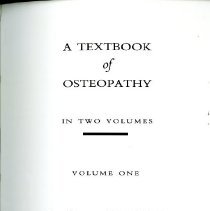
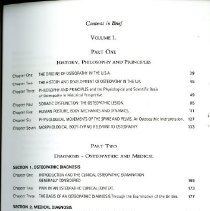
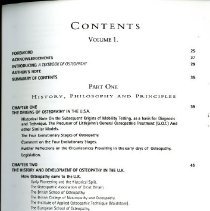
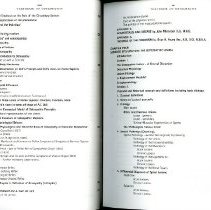
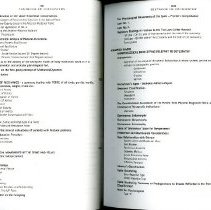
Additional Images [5]
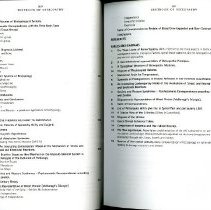


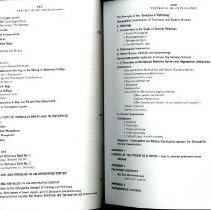
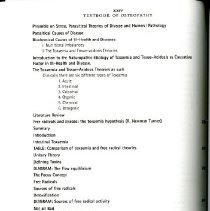
Metadata
Catalog Number |
2019.19.115 |
Accession number |
2019.19 |
Object Name |
Book |
Title |
A Textbook of Osteopathy |
Published Date |
1999 |
Summary |
A Textbook of Osteopathy, Volume One; 1999. Written by Tom Dummer, published by JoTom Publications in East Sussex, white softcover book with black lettering on cover and spine "A Textbook of Osteopathy"; 18.8 cm (w) x 26 cm (h); 248 pages. Edges of cover are worn, bottom right portion of book bent upwards, bends on spine, scratches on cover, acid burns on edges of book pages. |
Credit line |
Museum of Osteopathic Medicine |
People |
Dummer, Jo Dummer, Tom Young, M. H. |
Search Terms |
Textbook of Osteopathy JoTom Publications Kirksville College of Osteopathic Medicine Library History Philosophy Principles Origins of Osteopathy in the United States of America Historical Note on the Subsequent Origins of Mobility Testing Basis for Diagnosis and Technique Precursor of Littlejohns General Osteopathic Treatment Similar Models Four Evolutionary Stages of Osteopathy Comment on the Four Evolutionary Stages Circumstances Prevailing in the early days of Osteopathy History and Development of Osteopathy in the United Kingdom How Osteopathy came to the United Kingdom Early Pioneering and the Historical Split Osteopathic Association of Great Britain British School of Osteopathy British College of Naturopathy and Osteopathy Institute of Applied Osteopathic Technique Maidstone European School of Osteopathy Legislation in the United Kingdom Philosophy and Principles Physiological and Scientific Basis of Osteopathy in Historical Perspective Stills Precepts Stills Precepts Principle Stills Intuition and Spiritual Insight Traditional Emphasis on the Role of the Circulatory System Organismic interpretation of life phenomena Environment and the individual Homeostasis Laborits Oscillating reaction Inner-centre and consciousness Holism in Osteopathy Examples of Holism Total Lesion Osteopathy Irvin Korrs contribution to Osteopathy Philosopher as well as Scientist Research into Body Mechanics Concluding Dissertation on Stills Precepts and Stills views on Homo-Sapiens Structure Governs Function Postural Mechanical Influence Reflex Irritation Related Etiological Influences Vertical Aspects Horizontal Aspects Function governs or modifies structure Three levels of Homo Sapiens Structure Function Mind William Sutherlands views Contemporary Conceptual Model of Osteopathic Principles Physiological Balance Visceromotor Reflex Viscero-Sensory Reflex Viscerotrophic Reflex Somatico-Visceral Reflex Osteopathic Principles Way of Life Unity of the Person Medicatrix naturae Care of the physician within Primacy of the musculoskeletal system Somatic Dysfunction Osteopathic Lesion Disturbed Physiology Lesion Etiology Displacement Symptomatology Basic etiology Etiology Lesion primary Lesion secondary Skeletal Muscular Hypertension or Spasms Pathological Vicious Circle Special Pathology Pathology of the Lesion Pathology of the Intervertebral Disc Pathology of the Muscles Acute Lesions Chronic Lesions Pathology of the Ligaments Pathology of the Nerve Tissues Differential Diagnosis of Spinal Lesion Inspection Palpation Mobility Decubitus Primary and Secondary Spinal-Lesions Primary Reflex Lesion Secondary Reflex Lesion Structuro-Mechanical Spinal Lesions Abnormal Movement Position Simple Lesions Complex Lesions Simple Vertebral Lesions Hyperflexion lesions Extension lesions Lateral lesions Anterior lesions Postural lesions Compression lesions Impaction lesions Complex Vertebral Lesions Lesions found in different spinal areas Ribs lesions Cervical region Lesionology Structuro mechanical lesions Second Structuro Mechanical Spinal Lesions Third Structuro Mechanical Spinal Lesions Complicated Lesions Miscellaneous Lesions Direct Lesions Indirect Lesions Muscular Lesions Ligamentous Lesions Lesion Compensatory Dormant Lesion Rib Lesions Contemporary view of the Theoretic Basic of the Somatic Dysfunction Lesions Contemporary view of the Theoretic Basic of the Osteopathic Lesion Role of Nociceptive Reflex Positional Lesions Lesions of the extremity joints Total Lesion after Fryette Functional Lesion Osteopathic Lesion Phenomena Human Posture Body Mechanics Dynamics Normal Posture and Structural Integrity Congenital Developmental Adaptive Acquired Biotypological consideration Normal Posture Head Neck relationship Posture and Energy Expenditure Energy Expenditure Physio-pathological consequences of bad posture Psychological and psychosomatic consequences of bad posture Emotionally Behaviourally Basic principles in postural re-education Points in postural assessment Method of postural assessment Body Mechanics in an Osteopathic Context Body Dynamics in an Osteopathic Context Typical Distortion Gravitational lines of force Anterio-Posterior Line Postero-Anterior Lines Polygons of Force Triangles of Force Curved Line Pivot Lateral Plane Gravity Lines Anterior-Posterior Balance Procedures Postural distortions Antero-Postero Equilibrium Lateral Equilibrium Torsion Stress Acute torsion lesions Chronic torsion lesions Principles of Mechanics System of Forces Parallelogram of Forces Shear Force Centre of Gravity Moment of Intertia Work and the Conservation of Effort Weight Direction of a Force Sense of a Force Amplitude of a Force Motor Force Resistance Force Static Exercises Dynamic Exercises Physiological Movements of the Spine and Pelvis Spinal Terminology Easy Normal Flexion Extension Flexion Rotation Sidebending Combined Rotation and Sidebending Physiological Movements of the Spine Palpatory Findings in relation to the Two Laws Morphological Body-Typing Relevant to Osteopathy Kretschmers types Asthenic Athletic Pkynic Sheldons Classification Ectoderm Mesoderm Endoderm Constitutional Assessment of the Patient from Physical Diagnostic Data Consequent Therapeutic Indications Dominance Endomorphy Mesomorphy Ectomorphy Sheldonian Scale for Temperament Endocrinal and Neurological Considerations Type Relations with Disease Gastric Ulcer Duodenal Ulcer Gall Bladder Pernicious Anaemia Diabetes Melitus Acute Rheumatic fever Rheumatoid Arthritis Infantile Paralysis Vanniers Classification Over-Reactive Type Under-Reactive Type Predispositions to Disease Reflected in the Threefold Classification Psychological Biotypological Systems Psychosomatic Correspondences with the Three Body-Types Embryological Tissue Groups Endodermic Group Ectodermic Group Physiognomy Physiognomic Diagnosis Cranium Brow Nose Mouth Predominant Nose Crude Mouth Ancient Eastern Systems of Biotypology Tibetan Medicine Ayruvedic Medicine Mazdoznan Philosophy Ancient Greek Choice of Treatment Prognosis Children and Parents Heterodox Medical Theories Relevant to Osteopathy Neurogenic Theories Reillys Phenomena R Coujards experiments Selyes General Adapation Syndrome Oscillating Post-Stress Reaction Mechanism of Stress Three Reactive Stages Musculo-Skeletal System Principle of the Evolution of Pathology Selyes Reactive Stages Stage of Resistance Exhaustion Stage Anxiety and Pleasure Syndromes Psychosomatic Correspondences McDonaghs Unitary Theory Blood Protein Pre-Colloidal Half of the Spiral Nascent Independence Beginnings of Independence Independence Sympatheticotonia Vagotonia Protein of Blood Over-Expanded and Over-Contracted Spinal Pain Three Unities Toxaemia theory Free Radical theory Flow Equilibrium Free radical activity Osteopathic Diagnosis Osteopathic Examination Osteopathic Clinical Examination Structural mechanical Level Functional Level Total Diagnostic Examination Osteopathic Examination Proper Structural Mechanical Functional Dynamic Appraisal Cranial Functional Bioenergetic assessment Clinical Osteopathic Examination Medical screening as a priority Musculo-skeletal pathology 1st Degree Lesions 2nd Degree Lesions 3rd Degree Lesions Downing describes the process Alarm Stage Corresponding Muscle States Hypertonic Hypertonicfibrotic Atrophic fibrotic Pain in an Osteopathic Clinical Context Differential Diagnosis Bilateral pain Acute Pain Sub-acute pain Chronic pain Heads Law Thoracic Pain Cardiac Pain Abdominal Pain Acute Abdomen Liver Pain Differential Diagnosis of Peripheral Pain Differential Diagnosis of Contraction Spasm of Musculo-skeletal and Visceral Origin Decubitus Patient Standing Decubitus Patient Recumbent Pain Itself Weight Bearing Structures Central Pain Basis of an Osteopathic Diagnosis Unities Structuro-Mechanical Examination Postural-Mechanical Evaluation Five Procedures Generalities Anatomical Physiology Aspects Articular Physiology Aspects Evolving Osteopathic Concepts Shock Absorber Mechanisms Congenital Anomalies Special Pathological Consideration of the Lumbo-sacral area Pelvic Ring Continuous articular mechanism Holistic Principle Unity Number One Sacrococcygeal Lesions Examination of Unity Number One Gossip Test Forward-bending Test Side-bending Test Sitting Lateral shift Test Tests for Anatomical Short-leg Halls Test Behaviour of Lumbar Spine Sitting Prone Tests Elys Tests Lumbar Rotation Test Functional Test for the Sacroiliacs Side Posture Sacroiliac Tests Lumbo-Sacral and Lumar Articulation Test Supine-Downings Test Diagnostic Objectives of this Examination Examination of Unity Number 2 Upper Cervical Area Lower Cervical Area Occipitol-atlantal Articulation Flexion Extension Atlanto-Axial Articulation Pure Rotation Axis Articulation C3 Articulation Pure Side-Bending C4 Articulation Pure Flexion Pure Extension Cervical Spine Supine Position Examination of Unity Number 3 Anatomical Considerations Osteopathic Lesioning Visceral Physiological Relationships Examination Routine Rib-cage Thoracic Spine Thorax Anterior Rib cage Shoulder Girdles Postural Curve Syndrome Muscular Chains Synthesis of the Unities Postural Habit Patterns Osteopathic General Assessment Routine Testing for Unity Number 1 Standing Prone Sidelying Supine Methods Short leg Long leg Routine for Testing for Unity Medical Diagnosis Respiratory Circulatory Urinary Alimentary Integumentary Endocrine Nervous Sleep Sex Factors Metabolism Residence Abroad Assessment of Vitality Menstruation General Hygiene Mental and Emotional Habitus Ability for Creativity and Self Expression Nutritional Aspects Medical Diagnosis within an Osteopathic Context Respiration Cardiovascular System Heart Arteries Veins Liver Renal Dietetic Digestive Nervous System Endocrines X-Ray Diagnosis Use of X-Rays both positional and pathological in osteopathic practice X-Ray Images X-Ray Image Formulation Principles of Anatomical Distortion Pelvis Anatomical Distortion Anterior Right Rotation Lateral View Left Lateral Displacement Normal Pelvis Bilateral Anterior Pelvis Bilateral Posterior Pelvis First degree Pelvis Second Degree Pelvis Rotated Pelvis Sacroiliac Lesion Ilio-Sacral Lesion Third-Degree Pelvis Scissor Phenomenon Positional X-ray Interpretation Antero View Posterior View Upper Cervicals and Occiput Lateral View Upper Cervicals Spinal Column Various Considerations Relating to the Taking of Positional X-Rays Positioning in Radiography Anatomical and Physiological Considerations Lumbo-Pelvis X-Rays Upper Cervical X-Rays Comparative X-Rays X-Ray Proof of Osteopathic Lesion Laboratory Tests of Particular Importance to Osteopaths Hematology Blood Chemistry Serum Alkaline Phosphatase Serum Acid Phosphates Serum Calcium Low High Serum Uric Acid Etiology and Pathology in an Osteopathic Context Structural and Mechanical Biochemical Osteopathic Classification of Functional and Organic Diseases Pathology Study of General Pathology Purely Physiological Physiopathological Pathophysiological Pathological state Pathological Mechanisms Acute Disease Infection Epidemiology Astronomers predict epidemic of viruses Discussion on the Natural Protective Barriers and Regenerative Mechanisms and Processes General Defence Mechanisms Natural Protective Barriers Inbuilt Compensating Mechanisms Detoxification Processes Rejection Mechanisms Tolereance Encapsulation Host-Defence Mechanisms against Infection Non-specific mechanisms Specific Mechanisms Complement System Organ Inferiority Clinical Applications Anatomy Physiology Physio-pathology Patho-physiology End pathology morbid anatomy Panoramic vision Palpatory Diagnosis Naturopathic Etiology Stress Parasitical Theories of Disease Humeral Pathology Parasitical Causes of Disease Biochemical Causes of Ill-Health and Diseases Nutritional Imbalances Toxaemia Tissue acidosis Theories Naturopathic Etiology of Toxaemia Tissue Acidosis Causative Factor in Ill-Health and Disease Toxaemia Theories Acute Intestinal Catarrhal Organic Chemical Latrogenic Toxaemia hypothesis Intestinal Toxaemia Unitary Theory Focus Concept Free Radicals Detoxification Radical Mediated Conditions Hypersensitivity and Allergy Arthritis and rheumatism Atherosclerosis Neurology Ageing |
